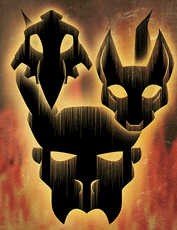Visage
"This is the port of Visage, where faces may not be naked. Except one: a stone monument the size of a village church, serenely gazing upwards. Flourishing-of-Years."[1]
Visage is an island of masks, located in the southern Unterzee.
Everyone Plays A Part
"Hide your face! Hide all your faces."[1]
Everyone on the island of Visage wears a mask, typically representing an animal. Each mask corresponds to a certain societal role:[2] for instance, traders and thieves wear locust masks,[3] soldiers wear crocodile masks,[4] and spies wear bat masks.[5] New arrivals learn the specifics and expected behavior of their roles at the Library of Parts.[6][7] Once a mask is chosen, its wearer must play their assigned part.[8][2]
There is only one face left uncovered on Visage: an enormous stone face looking skyward, called Flourishing-of-Years.[9] This face is hollow, and can be entered through its ear; entry is typically allowed during festivals. In the complete darkness within,[10] the island's inhabitants remove their masks and trade secrets,[11] though nobody knows whose secrets are whose.[12]
Other notable landmarks hint at the origins of Visage's culture. The Flood Court is always flooded to a certain degree, in emulation of what was once a yearly cycle.[13] The Apis Temple is inhabited by a perpetually wounded bull,[14] and by priests who are constantly collecting its blood.[15]
The Masks of Visage

"Each mask declares a different intention towards the denizens of Visage, and must be accompanied by suitable behavior."[16]
For every part played in the ritual life of Visage, for every personality and caste within its society, there is a mask. Each person is expected to follow the nature of their mask, and play their part in the grand play that goes on here. Here are just a few:[17]
- Frogs, normally newcomers to Visage, wear elaborate and noisy costumes[18] that prevent any attempts at stealth.[19] They are expected to be goofy, playful, and generally ditzy,[20] which doesn't make them very popular.[21]
- Locusts are the masks of traders, thieves, and various other greedy folk.[3] With the assistance of their masks, which help them spot valuables more easily,[22] Locusts are expected to put money above all other thoughts.[23] It is not uncommon to see them swarming over the money pools of the Flood Court.[24]
- Very few people play the part of the Bat, as these are always messengers or spies - and they always die.[5] They are to be killed on sight,[25] and as such stay hidden in the shadows.[26]
- Moon Moths are at once customs agents and tour guides.[27] Most new members of Visage are often shadowed by a Moon Moth in order to make sure the newcomer knows how to play their role - and that they don't cause trouble. The Moon Moth is often a senior member who has spent years on the island.[28]
- Cobras are respected members of society who hold more important tasks in Visage's society; the Chief Geometer is a Cobra who apportions land for each resident of Visage to forage for food.[29] To be invited into the home of a Cobra is considered an honor.[30]
- Lions fulfill a similar role to Cobras, but a more ceremonial one, as they are primarily worshippers of Flourishing-of-Years.[31]
- Crocodiles sail overzee to enforce the will of Visage.[32][33] At least some Crocodiles are performing their role as penance for violating the rules of the island.[34]
- Jackals are enforcers who protect the ritual of entering the Flourishing-of-Years. They ensure that every member plays their part,[35] and mete out punishment upon those who do not.[36]
There are, of course, many other parts in the great play that is Visage. These are just the main players. But be warned: to not play one's part, or to remove one's mask, is a recipe for disaster.[37]
Origins
Visage was originally an outpost of the Second City. It was abandoned for unknown reasons, but repopulated by a different group.[38] It seems the colony's re-founding has to do with a man losing his lover and, for some reason, a jillyfish.[39][40]
The Flood Court is an interpretation of the way ancient Egyptians recorded the annual flooding of the Nile River.[13][41] While the Unterzee itself does not flood, the detailed records of the Egyptians allow the people of Visage to simulate the natural calendar flood cycles from when their ancestors lived on the Surface.[13]
Animal masks also had a significant role in Egyptian culture. Priests and higher members of society often wore such masks to represent the animals of the Nile. It is often thought that the mask would gift the wearer with the virtues and powers of the animal shown. Many festivals and religious celebrations often had such masks to hold reverence to the creatures who were thought to be messengers and eyes of the Gods. Even more convincingly, all the masks feature animals that were worshipped by Egyptians, save for the bat and the moon moth. The Moon Moths are clearly inspired by Jack Vance's "The Moon Moth," a short story about a diplomat trying to catch a criminal in a society where everyone wears masks. And the bats... well.
The most obvious pointer toward Visage's Egyptian origin is Apis Temple, which preserves the traditions of the bull god Apis. A long series of ritually perfect bulls, who all bore specific markings that made them so, were identified by the god's priests and housed in temples for their entire lives. If they lived past a certain age, they were sacrificed. In keeping with this, the priests of Apis Temple note that if the bull dies, a new one with the same markings will be born somewhere around the Unterzee and brought to the temple.[42]
References
|